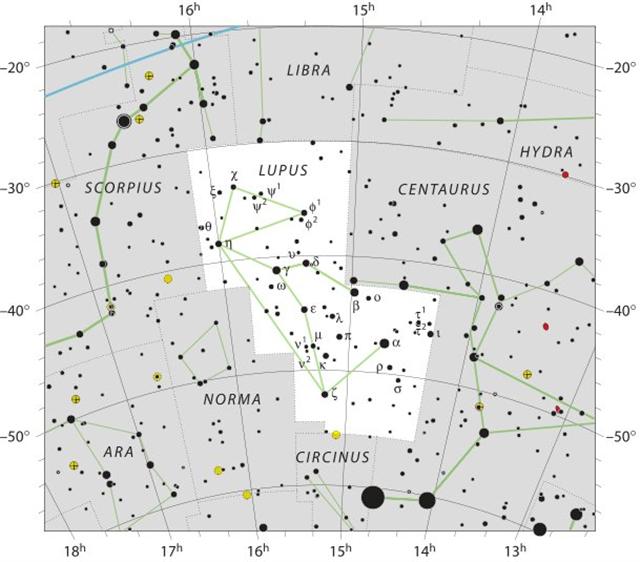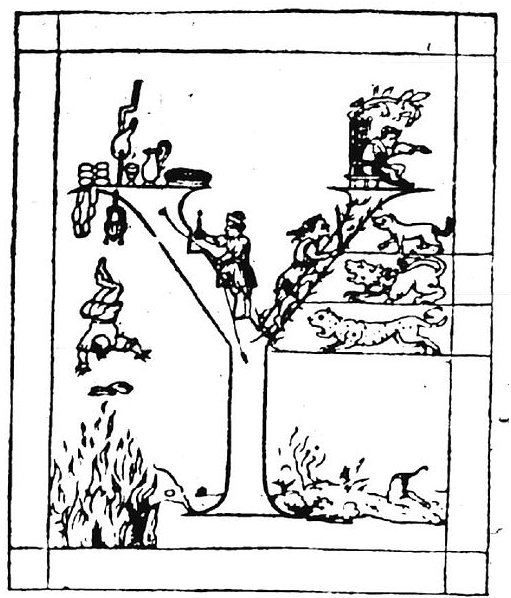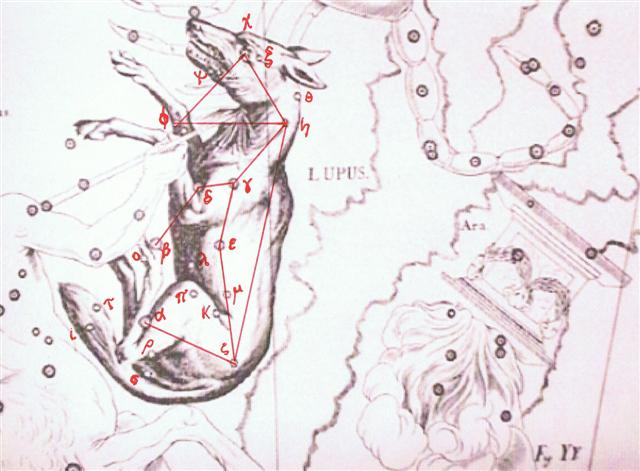The shadows of the low down Lupus constellation at the end of the K text apparently are in contrast to the light dawning 2 months later at the end of side a on the G tablet.
According to Hevelius the point of Centaurus' spear hits the Wolf at his throat, and this point lies somewhere between φ and η.
The first star to rise in Lupus is iota in right ascension day 216, the day after Gregorian day 295:
 |
 |
 |
 |
 |
| Kb4-1 (146) |
Kb4-2 |
Kb4-3 |
Kb4-4 |
Kb4-5 (*216) |
| υ² Centauri (211.8), τ Virginis (211.9), Agena (212.1) |
Thuban (212.8), χ Centauri (213.0), Menkent (213.1) |
|
Asellus Tertius, κ Virginis (214.8), Arcturus (215.4) |
Asellus Secundus (215.5), Syrma, λ Bootis (215.6), ι Lupi (216.3), Khambalia (216.4) |
| 'October 19 |
'14h (213.1) |
'21 |
'22 (295) |
'23 |
| Assarfa 12 |
13 (157) |
Auva 1 |
2 |
3 |
Beyond ι Lupi follows a viri, the first of 4 glyphs leading up to Gregorian day 300:
 |
 |
 |
 |
| Kb4-6 |
Kb4-7 (152) |
Kb4-8 |
Kb4-9 (*220) |
| υ Virginis (216.5), ψ Centauri (216.6) |
Asellus Primus (217.8), τ Lupi (218.1) |
φ Virginis (218.7), σ Lupi (219.1) |
ρ Bootis (219.5), Haris (219.7). σ Bootis (220.2), η Centauri (220.4) |
| 'October 24 |
'25 |
'26 |
'27 (300) |
| Auva 4 |
5 |
6 |
7 (164) |
The Wolf constellation is close to the pole and its stars cover many days:
 |
 |
 |
 |
 |
| Kb4-10 |
Kb4-11 |
Kb4-12 (157) |
Kb4-13 |
Kb4-14 (*225) |
| ρ Lupi (221.0), Toliman (221.2 |
π Bootis (221.8), ζ Bootis (221.9), Yang Mun (222.1) |
Rijl al Awwa (222.5), ο Bootis (222.9), Izar (223.0), 109 Virginis (223.3) |
Zuben Elgenubi (224.2) |
ξ Bootis, ο Lupi (224.5), Kochab (225.0) |
| 'October 28 |
'29 |
'30 |
'31 (304) |
'November 1 |
| Auva 8 |
9 |
10 |
11 (168) |
12 |
 |
 |
 |
 |
| Kb4-15 (160) |
Kb4-16 |
Kb4-17 |
Kb4-18 (*229) |
| Ke Kwan (226.3), Ke Kwan (226.4) |
Zuben Elakribi (226.8), Nekkar (227.3) |
π Lupi (227.9), Zuben Hakrabim (228.3) |
λ Lupi (228.9) |
| 'November 2 |
'3 |
'4 (308) |
'5 |
| Auva 13 (170) |
Simak 1 |
2 |
3 |
 |
| Kb4-19 (164) |
| κ Lupi (229.7), ζ Lupi (229.8) |
| 'November 6 (310) |
| Simak 4 (174) |
 |
 |
 |
 |
 |
 |
| *Kb5-2 (1) |
*Kb5-3 |
*Kb5-4 |
*Kb5-5 |
*Kb5-6 |
*Kb5-7 (*236) |
| Zuben Elschemali (230.8), μ Lupi (231.3) |
ο Cor. Borealis (232.0), δ Lupi (232.1), φ¹, ν² Lupi (232.2), ν¹ Lupi (232.3), ε Lupi (232.4) |
φ² Lupi (232.5), Pherkad (232.6), η Cor. Borealis (232.8), υ Lupi (232.9), Alkalurops (233.1) |
Nusakan (234.0) |
θ Cor. Borealis (235.3) |
γ Lupi (235.6), Gemma, Zuben Elakrab, Qin (235.7), μ Cor. Borealis (235.8), ω Lupi (236.3) |
| 'November 7 |
'8 |
'9 |
'10 (314) |
'11 |
'12 |
| Simak 5 |
6 |
7 (177) |
8 |
9 |
10 (180) |
 |
 |
... |
 |
 |
| *Kb5-9 (7) |
*Kb5-10 |
*Kb5-12 (9) |
*Kb5-13 (*240) |
| ψ¹ Lupi (236.7), ζ Cor. Borealis (236.9), ι Serpentis (237.4) |
ψ² Lupi (237.5), γ Cor. Borealis (237.7), Unuk Elhaia (237.9), π Cor. Borealis, Cor Serpentis (238.1) |
Chow (238.6), κ Serpentis (239.3) |
δ Cor. Borealis, Tiānrǔ (239.5), χ Lupi, (239.6), ω Serpentis (239.7), Ba, χ Herculis (239.8). κ Cor. Borealis, ρ Serpentis (239.9) |
| 'November 13 |
'14 |
'15 |
'16 (320) |
| Simak 11 |
12 |
13 |
Syrma 1 (184) |
 |
 |
 |
 |
| *Kb5-14 |
*Kb5-15 (12) |
*Kb5-16 (177) |
*Kb5-17 (*244) |
| ρ Scorpii (240.8), ξ Lupi, λ Cor. Borealis (241.1), Zheng (241.2), Vrischika (241.3) |
ε Cor. Borealis (241.5), Dschubba (241.7), η Lupi (241.9), υ Herculis (242.3), ρ Cor. Borealis (242.4) |
ι Cor. Borealis (242.5), ξ Scorpii (242.7), Acrab, Jabhat al Akrab (243.3) |
θ Lupi, Rutilicus (243.5), Marfik (243.7), φ Herculis (243.8) |
| 'November 17 |
'18 |
'19 |
'20 |
| Syrma 2 |
3 |
4 |
5 |
Maybe the crucial star is χ Lupi because it is at the eye of the Wolf. It is located 240 days from equinox.
"In the system of Greek numerals, it [χ] has a value of 600." (Wikipedia)
If we wish to compare with the G text, where a corresponding structure evidently comes ca 2 months later, we should look at the glyphs at the beginning of side b.
 |
 |
 |
 |
 |
| Gb1-4 |
Gb1-5 |
Gb1-6 (236) |
Gb1-7 (*300) |
Gb1-8 |
| |
Sham (297.8) |
Tarazed (299.3) |
Altair (300.3) |
|
| 'January 12 (377) |
'13 |
'14 |
'15 |
'16 |
| 10 |
11 |
12 |
Shaula 13 |
Al Naam 1 |
 |
 |
 |
 |
 |
| Gb1-9 |
Gb1-10 (240) |
Gb1-11 |
Gb1-12 |
Gb1-13 |
| Alshain (301.6), ε Pavonis (302.3) |
μ Pavonis (302.7) |
δ Pavonis (304.4) |
|
ξ Capricorni (305.8) |
| 'January 17 |
'18 |
'20h (304.4) |
'20 |
'21 (386) |
| Al Naam 2 |
3 |
4 |
5 |
6 (250) |
Gb1-7 is glyph number 237 and can therefore (by the force of numbers) be compared with *Kb5-9 and ψ¹ Lupi. 237 = 8 * 29½ + 1 in both cases.
*Kb5-13 and χ Lupi (*240) should correspond to Gb1-10. And the very special Gb1-13 should correspond to glyph 177 in K. This (*Kb5-16) is the only fully visible vai glyph in K, but there seems to be a half visible one in Ka2-4:
 |
 |
 |
 |
 |
| Ka2-1 |
Ka2-2 |
Ka2-3 (*88) |
Ka2-4 |
Ka2-5 (24) |
| γ Leporis (85.9) |
Saiph (86.5), ζ Leporis (86.6) |
Wezn (87.6), δ Leporis (87.7), Betelgeuze (88.3) |
η Leporis (89.0), Praja-pāti, Menkalinan, Mahashim, and γ Columbae (89.3) |
η Columbae (89.7), μ Orionis (90.3) |
| 'June 15 |
'16 |
'17 (168) |
'18 |
'19 |
| Albatain 3 (30) |
4 |
5 |
6 |
7 |
| 152 |
 |
4 |
| *Kb5-16 (177) |
| |
ι Cor. Borealis (242.5), ξ Scorpii (242.7), Acrab, Jabhat al Akrab (243.3) |
|
| 152 |
'November 19 (323) |
4 |
| Syrma 4 (187) |
| 157 (= 314 / 2) |
Sham (the Arrow star) is in position 236 - 1 and can be compared with *Kb5-6:
 |
 |
 |
 |
 |
 |
| *Kb5-2 (1) |
*Kb5-3 |
*Kb5-4 |
*Kb5-5 |
*Kb5-6 |
*Kb5-7 (*236) |
| Zuben Elschemali (230.8), μ Lupi (231.3) |
ο Cor. Borealis (232.0), δ Lupi (232.1), φ¹, ν² Lupi (232.2), ν¹ Lupi (232.3), ε Lupi (232.4) |
φ² Lupi (232.5), Pherkad (232.6), η Cor. Borealis (232.8), υ Lupi (232.9), Alkalurops (233.1) |
Nusakan (234.0) |
θ Cor. Borealis (235.3) |
γ Lupi (235.6), Gemma, Zuben Elakrab, Qin (235.7), μ Cor. Borealis (235.8), ω Lupi (236.3) |
| 'November 7 |
'8 |
'9 |
'10 (314) |
'11 |
'12 |
| Simak 5 |
6 |
7 (177) |
8 |
9 |
10 (180) |
The spear point of Centaurus could very well be comparable to the point of an arrow, and perhaps the target of the spear is υ Lupi (above δ and γ) in manzil day 177:

"In the system of Greek numerals it [υ] has a value of 400. It is derived from the Phoenician waw

... Upsilon is known as Pythagoras' letter, or the Samian letter, because Pythagoras used it as an emblem of the path of virtue or vice. As the Roman writer Persius wrote in Satire III:
-
and the letter which spreads out into Pythagorean branches has pointed out to you the steep path which rises on the right.
Lactantius, an early Christian author (ca. 240 - ca. 320), refers to this:
-
For they say that the course of human life resembles the letter Y, because every one of men, when he has reached the threshold of early youth, and has arrived at the place 'where the way divides itself into two parts', is in doubt, and hesitates, and does not know to which side he should rather turn himself“..." (Wikipedia)

(Geoffroy Tory, Ypsilon)
|
























